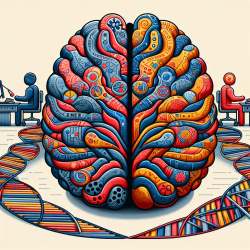Introduction
As practitioners in the field of speech-language pathology, understanding the underlying mechanisms of brain function is crucial for improving therapeutic outcomes. Recent research has unveiled fascinating insights into brain asymmetry, particularly how genetic variants can influence this phenomenon. The study titled Common Genetic Variant in VIT Is Associated with Human Brain Asymmetry sheds light on these genetic influences, providing valuable information that can be leveraged in therapeutic settings.
Understanding Brain Asymmetry
Brain asymmetry refers to the structural and functional differences between the two hemispheres of the brain. This asymmetry is a normal variation among individuals and plays a significant role in various cognitive functions, including language processing. The study highlights that a single nucleotide polymorphism (SNP), rs11691187, within the VIT gene, is significantly associated with variations in cortical surface area asymmetry.
Implications for Speech Therapy
The findings of this research have profound implications for speech therapy, particularly in understanding the biological underpinnings of language disorders. By recognizing that genetic factors contribute to brain asymmetry, practitioners can better tailor their therapeutic approaches. Here are some ways to implement these findings:
- Personalized Therapy: Incorporate genetic information to customize therapy plans that align with the individual’s neurological profile.
- Enhanced Assessment: Use insights from genetic studies to refine assessment tools, focusing on asymmetry-related language processing challenges.
- Targeted Interventions: Develop interventions that specifically address asymmetrical brain functions, potentially improving language acquisition and processing.
Encouraging Further Research
While this study provides a foundational understanding, it also opens avenues for further research. Practitioners are encouraged to explore the following areas:
- Broader Genetic Studies: Conduct studies that include diverse populations to understand the global impact of genetic variants on brain asymmetry.
- Longitudinal Studies: Investigate how brain asymmetry and its genetic influences evolve over time and impact language development.
- Cross-disciplinary Collaboration: Work with geneticists and neuroscientists to integrate genetic findings into practical therapeutic applications.
Conclusion
The intersection of genetics and brain asymmetry offers a promising frontier for enhancing speech therapy practices. By embracing data-driven approaches and continuing to explore the genetic foundations of brain function, practitioners can significantly improve outcomes for children with language disorders. To delve deeper into the original research, please follow this link: Common Genetic Variant in VIT Is Associated with Human Brain Asymmetry.










